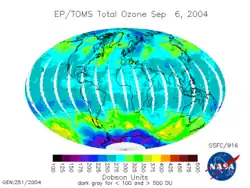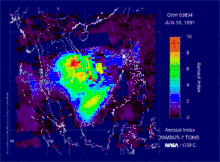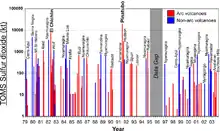Total Ozone Mapping Spectrometer
The Total Ozone Mapping Spectrometer (TOMS) was a NASA satellite instrument, specifically a spectrometer, for measuring the ozone layer. Of the five TOMS instruments which were built, four entered successful orbit. The satellites carrying TOMS instruments were:
- Nimbus 7; launched October 24, 1978. Operated until 1 August 1994. Carried TOMS instrument number 1.
- Meteor-3-5; launched 15 August 1991. Operated until December 1994. Was the first and last Soviet satellite to carry a USA made instrument. Carried TOMS instrument number 2.
- ADEOS I; launched 17 August 1996. Operated until 30 June 1997. Mission was cut short by a spacecraft failure.
- TOMS-Earth Probe; launched on July 2, 1996. Operated until 2 December 2006. Carried TOMS instrument number 3.
- QuikTOMS; launched 21 September 2001. Suffered launch failure and did not enter orbit.

Nimbus 7 and Meteor-3-5 provided global measurements of total column ozone on a daily basis and together provided a complete data set of daily ozone from November 1978 to December 1994. After an eighteen-month period when the program had no on-orbit capability, TOMS-Earth Probe launched in 2 July 1996, followed by ADEOS I. ADEOS I was launched on August 17, 1996 and the TOMS-instrument onboard provided data until the satellite which housed it lost power on June 30, 1997.
TOMS-Earth Probe (Total Ozone Mapping Spectrometer - Earth Probe, TOMS-EP, originally just TOMS, COSPAR 1996-037A)[1] was launched on July 2, 1996 from Vandenberg AFB by a Pegasus XL rocket. The satellite project was originally known as TOMS, back in 1989 when it was selected as a SMEX mission in the Explorer program. However, it found no funding as an Explorer mission and transferred to NASA's Earth Probe program, getting funding and becoming TOMS-EP. The small, 295 kg satellite was built for NASA by TRW; the single instrument was the TOMS 3 spectrometer. The satellite had a two-year planned life. TOMS-EP suffered a two-year delay to its launch due to launch failures of the first two Pegasus XL rockets. The launch delays led to alternations in the mission; the satellite was placed in a lower than originally planned orbit to achieve higher resolution and to enable more thorough study of UV-absorbing aerosols in the troposphere. The lower orbit was meant to complement measurements from ADEOS I enabling TOMS-EP to provide supplemental measurements. After ADEOS I failed in orbit, TOMS-EP was boosted to a higher orbit to replace ADEOS I. The transmitter for TOMS-Earth Probe failed on December 2, 2006.[2]
The only total failure in the series was QuikTOMS, which was launched on September 21, 2001 on a Taurus rocket from Vandenberg AFB, but did not achieve orbit.[3]
Since January 1, 2006, data from the Aura Ozone Monitoring Instrument (OMI) has replaced data from TOMS-Earth Probe.[4] The Ozone Mapping and Profiler Suite on Suomi NPP and NOAA-20 have further continued the data record.
Gallery
 Image of the largest Antarctic ozone hole recorded to date (September 2006).
Image of the largest Antarctic ozone hole recorded to date (September 2006). Mount Pinatubo 1991 ash and aerosol.
Mount Pinatubo 1991 ash and aerosol. Mount Pinatubo 1991 sulfur dioxide.
Mount Pinatubo 1991 sulfur dioxide. Sulfur dioxide emissions from volcanoes.
Sulfur dioxide emissions from volcanoes.
References
- https://space.skyrocket.de/doc_sdat/toms-ep.htm
- "News". Total Ozone Mapping Spectrometer. NASA. March 5, 2007. Archived from the original on August 29, 2012.
- "QuikTOMS Mission". NASA. July 10, 2001. Archived from the original on August 21, 2001.
- "TOMS turns the mapping job over to OMI". Total Ozone Mapping Spectrometer. NASA. January 9, 2006. Archived from the original on January 27, 2006.
External links
| Wikimedia Commons has media related to Total Ozone Mapping Spectrometer. |
Further reading
- Bhartia, Pawan Kumar; McPeters, Richard D. (2018). "The discovery of the Antarctic Ozone Hole". Comptes Rendus Geoscience. Elsevier BV. 350 (7): 335–340. doi:10.1016/j.crte.2018.04.006. ISSN 1631-0713.